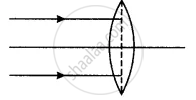Advertisements
Advertisements
Question
An object is placed at a distance of 20 cm in front of a concave lens of focal length 20 cm. find: the magnification of image.
Solution
Object distance, u = -20 cm
Focal length, f = -20 cm (concave lens)
For a lens, magnification is
m = `"v"/"u"`
`therefore "m" = (-10)/-20`
∴ m = + 0.5
APPEARS IN
RELATED QUESTIONS
A lens forms an erect, magnified, and virtual image of an object. Name the device which uses this principle.
Ray diagram for the formation of image by a magnifying glass.

Define the term magnifying power of a simple microscope. How does it depend on the focal length of the lens used?
Why is the focal length of the lens, used as a magnifying glass, kept short?
Will the image formed by a magnifying glass be real or virtual?
Name the lens for which magnification can be 1. For what position of the object will the magnification be 1?
A convex lens produces on a screen an image twice the size of the object. If the position of image and object be interchanged, what will be the magnification then?
What is a simple microscope or a magnifying glass? Draw a ray diagram to show its function.
Copy and complete the following ray diagram.

What is a magnifying glass (or a simple microscope)? Draw a ray diagram to show how a convex lens may be used as a magnifying glass. Where should the object be placed? State three characteristics of the image formed.
